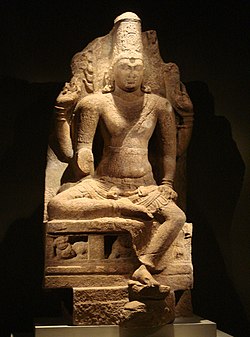| Maha Upanishad | |
|---|---|
 The text discusses Narayana (Vishnu) | |
| Devanagari | महा |
| IAST | Mahā |
| Title means | Great[1] |
| Type | Vaishnava[1] |
| Linked Veda | Samaveda[2] |
| Chapters | 6 |
| Verses | 549[3] |
| Philosophy | Vaishnavism |
The Maha Upanishad (Sanskrit: महा उपनिषद्, IAST: Mahā Upaniṣad) is a Sanskrit text and is one of the minor Upanishads of Hinduism.[4][5] The text is classified as a Samanya Upanishad.
The text exists in two versions, one attached to the Atharvaveda in some anthologies,[6] and another attached to the Samaveda.[5] The Atharvaveda version is shorter, and in prose.[7][8] The Samaveda version is partly in poetic verses.[9]
The Vaishnava Upanishad describes Vishnu as the highest being, and above Brahma.[1] [10] Both groups of texts, however, use reverential words of all Hindu gods, and assert them to be the same Atman-Brahman.[10] The Upanishad presents a syncretism of Vaishnava and Vedanta ideas, and is notable for its teaching of "Vasudhaiva Kutumbakam", or "the world is one family".[11][12][13]
- ^ a b c Deussen 1997, p. 799.
- ^ Tinoco 1996, p. 89.
- ^ AG Krishna Warrier (1953), Maha Upanishad, Theosophical Society, Madras, Online
- ^ Deussen 1997, pp. 557, 561–567.
- ^ a b Tinoco 1996, pp. 87–89.
- ^ Deussen 1997, pp. 566–567.
- ^ Deussen 1997, pp. 799–801.
- ^ Max Muller, Alphabetisches Verzeichniss der Upanishads at Google Books, Zeitschrift der Deutschen Morgenländischen Gesellschaft: ZDMG, Volume 19, page 151
- ^ Hattangadi 2000.
- ^ a b Deussen 1997, pp. 779–782, 799–801.
- ^ Cite error: The named reference
jeffreymoses12was invoked but never defined (see the help page). - ^ Cite error: The named reference
robinseelan143was invoked but never defined (see the help page). - ^ BP Singh and Dalai Lama XIV Bstan-ʼdzin-rgya-mtsho (2008), Bahudhā and the Post 9/11 World, Oxford University Press, ISBN 978-0195693553, page 51